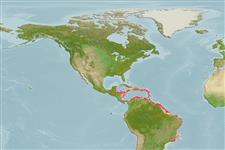Classification / Names
Common names from other countries
Main reference
Size / Weight / Age
Max length : 31.0 cm TL male/unsexed; (Ref. 5217); common length : 20.0 cm TL male/unsexed; (Ref. 3702); max. published weight: 500.00 g (Ref. 5217)
Environment
Marine; brackish; demersal; depth range 1 - 60 m (Ref. 9626)
Climate / Range
Tropical, preferred ?; 21°N - 26°S, 90°W - 34°W
Distribution
Short description
Dorsal
spines
(total): 11;
Dorsal
soft rays
(total): 24-26;
Anal
spines: 2;
Anal
soft rays: 7 - 8. Colour silvery grey, darker above. A dark spot at bases of pectoral fins. Pelvic and anal fins often yellowish. A medium-sized to small fish, short and robust. Mouth very large, strongly oblique, lower jaw projecting. Teeth very small and sharp, set in 1 or 2 rows along edges of jaws. Chin without barbels, but with 4 minute pores. Snout with 5 marginal pores, no rostral pores. Gas bladder with a pair of small, horn-like anterior appendages. Sagitta (large earstone) thick and short (Ref 51721).
IUCN Red List Status (Ref. 115185)
Threat to humans
Harmless
Human uses
Fisheries: commercial; bait: occasionally
More information
ReferencesAquacultureAquaculture profileStrainsGeneticsAllele frequenciesHeritabilityDiseasesProcessingMass conversion
Tools
Special reports
Download XML
Internet sources
Estimates of some properties based on models
Phylogenetic diversity index
PD50 = 0.5156 many relatives (e.g. carps) 0.5 - 2.0 few relatives (e.g. lungfishes)
Trophic Level
3.5 ±0.6 se; Based on diet studies.
Resilience
High, minimum population doubling time less than 15 months (Preliminary K or Fecundity.)
Vulnerability
Low vulnerability (25 of 100)
Price category
